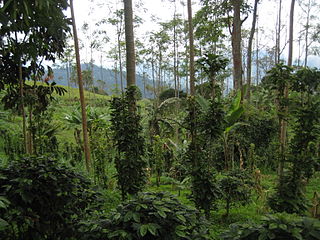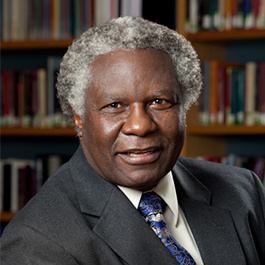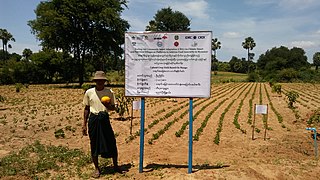Agriculture encompasses crop and livestock production, aquaculture, and forestry for food and non-food products. Agriculture is a key factor in the rise of sedentary human civilization, whereby farming of domesticated species created food surpluses that enabled people to live in the cities. While humans started gathering grains at least 105,000 years ago, nascent farmers only began planting them around 11,500 years ago. Sheep, goats, pigs, and cattle were domesticated around 10,000 years ago. Plants were independently cultivated in at least 11 regions of the world. In the 20th century, industrial agriculture based on large-scale monocultures came to dominate agricultural output.

Precision agriculture (PA) is a farming management strategy based on observing, measuring and responding to temporal and spatial variability to improve agricultural production sustainability. It is used in both crop and livestock production. Precision agriculture often employs technologies to automate agricultural operations, improving their diagnosis, decision-making or performing. The goal of precision agriculture research is to define a decision support system for whole farm management with the goal of optimizing returns on inputs while preserving resources.
Agronomy is the science and technology of producing and using plants by agriculture for food, fuel, fiber, chemicals, recreation, or land conservation. Agronomy has come to include research of plant genetics, plant physiology, meteorology, and soil science. It is the application of a combination of sciences such as biology, chemistry, economics, ecology, earth science, and genetics. Professionals of agronomy are termed agronomists.
The following outline is provided as an overview of and topical guide to sustainable agriculture:

Sustainable agriculture is farming in sustainable ways meeting society's present food and textile needs, without compromising the ability for current or future generations to meet their needs. It can be based on an understanding of ecosystem services. There are many methods to increase the sustainability of agriculture. When developing agriculture within sustainable food systems, it is important to develop flexible business processes and farming practices. Agriculture has an enormous environmental footprint, playing a significant role in causing climate change, water scarcity, water pollution, land degradation, deforestation and other processes; it is simultaneously causing environmental changes and being impacted by these changes. Sustainable agriculture consists of environment friendly methods of farming that allow the production of crops or livestock without causing damage to human or natural systems. It involves preventing adverse effects on soil, water, biodiversity, and surrounding or downstream resources, as well as to those working or living on the farm or in neighboring areas. Elements of sustainable agriculture can include permaculture, agroforestry, mixed farming, multiple cropping, and crop rotation.

Agricultural economics is an applied field of economics concerned with the application of economic theory in optimizing the production and distribution of food and fiber products. Agricultural economics began as a branch of economics that specifically dealt with land usage. It focused on maximizing the crop yield while maintaining a good soil ecosystem. Throughout the 20th century the discipline expanded and the current scope of the discipline is much broader. Agricultural economics today includes a variety of applied areas, having considerable overlap with conventional economics. Agricultural economists have made substantial contributions to research in economics, econometrics, development economics, and environmental economics. Agricultural economics influences food policy, agricultural policy, and environmental policy.
Agribusiness is the industry, enterprises, and the field of study of value chains in agriculture and in the bio-economy, in which case it is also called bio-business or bio-enterprise. The primary goal of agribusiness is to maximize profit while satisfying the needs of consumers for products related to natural resources such as biotechnology, farms, food, forestry, fisheries, fuel, and fiber.

Calestous Juma was a Kenyan scientist and academic, specializing in sustainable development. He was named one of the most influential 100 Africans in 2012, 2013 and 2014 by the New African magazine. He was Professor of the Practice of International Development and Faculty Chair of the Innovation for Economic Development Executive Program at Harvard Kennedy School. Juma was Director of the School's Science, Technology and Globalization Project at Harvard Kennedy School as well as the Agricultural Innovation in Africa Project funded by the Bill and Melinda Gates Foundation.
Water trading is the process of buying and selling water access entitlements, also often called water rights. The terms of the trade can be either permanent or temporary, depending on the legal status of the water rights. Some of the western states of the United States, Chile, South Africa, Australia, Iran and Spain's Canary Islands have water trading schemes. Some consider Australia's to be the most sophisticated and effective in the world. Some other countries, especially in South Asia, also have informal water trading schemes. Water markets tend to be local and informal, as opposed to more formal schemes.
The Association of Environmental and Resource Economists (AERE) was founded in 1979 in the United States as a means of exchanging ideas, stimulating research, and promoting graduate training in environmental and natural resource economics. The majority of its members are affiliated with universities, government agencies, non-profit research organizations, and consulting firms. Many of AERE's members hold graduate degrees in economics, agricultural economics, or related fields, but there are numerous student members as well. The organization also serves many non-specialist members with environmental policy interests. The United States is the country with the largest single share of AERE members, but the organization welcomes members from all countries. Annual individual memberships currently number approximately 800. AERE is generally acknowledged as the primary professional organization for Environmental and Natural Resources economists in the USA. The European Association of Environmental and Resource Economists is its European equivalent.

The Annual Review of Resource Economics peer-reviewed academic journal that publishes an annual volume of review articles relevant to natural resource economics. It was established in 2009 and is published by the nonprofit organization Annual Reviews. The current co-editors are Gordon Rausser and David Zilberman. As of 2023, it is being published as open access, under the Subscribe to Open model.

Rajamangala University of Technology Thanyaburi is a public university in Pathum Thani Province, Thailand. It was established on January 18, 2005, and is a member of the Rajamangala University of Technology system. It offers undergraduate programs in various fields such as engineering, industrial technology, agriculture, business administration, industrial design, architecture, fine arts, science and technology, education, mass communication technology, arts, Thai traditional medicine, and arts-related disciplines. The university aims to produce quality professionals in alignment with the rapidly changing fields of science and technology.
The Irrigated Rice Research Consortium (IRRC) focuses on agricultural research and extension in irrigated rice-based ecosystems. In partnership with national agricultural research and extension systems (NARES) and the private sector, the IRRC provides a platform for the dissemination and adoption of natural resource management (NRM) technologies in Asian countries. The IRRC is currently active in 11 countries: Bangladesh, Cambodia, China, India, Indonesia, Laos, Myanmar, the Philippines, Sri Lanka, Thailand, and Vietnam. It aims to strengthen NARES-driven interdisciplinary research, link research and extension, facilitate rice farmers' uptake of technological innovations, and enable environmentally sound rice production to expand to feed growing populations.
National Innovations in Climate Resilient Agriculture (NICRA) was launched during February 2011 by the Indian Council of Agricultural Research (ICAR) with the funding from the Ministry of Agriculture, Government of India. The mega project has three major objectives of strategic research, technology demonstrations and capacity building. Assessment of the impact of climate change simultaneous with formulation of adaptive strategies is the prime approach under strategic research across all sectors of agriculture, dairying and fisheries.
The water, energy and food security nexus according to the Food And Agriculture Organisation of the United Nations (FAO), means that water security, energy security and food security are very much linked to one another, meaning that the actions in any one particular area often can have effects in one or both of the other areas.
Digital agriculture, sometimes known as smart farming or e-agriculture, are tools that digitally collect, store, analyze, and share electronic data and/or information in agriculture. The Food and Agriculture Organization of the United Nations has described the digitalization process of agriculture as the digital agricultural revolution. Other definitions, such as those from the United Nations Project Breakthrough, Cornell University, and Purdue University, also emphasize the role of digital technology in the optimization of food systems.
Hans P. Binswanger-Mkhize was a Swiss economist. His research focused mainly on agricultural economics in developing countries.

Climate-smart agriculture (CSA) is a set of farming methods that has three main objectives with regards to climate change. Firstly, they use adaptation methods to respond to the effects of climate change on agriculture. Secondly, they aim to increase agricultural productivity and to ensure food security for a growing world population. Thirdly, they try to reduce greenhouse gas emissions from agriculture as much as possible. Climate-smart agriculture works as an integrated approach to managing land. This approach helps farmers to adapt their agricultural methods to the effects of climate change.

Elisabeth Sadoulet is an economist and Professor of Agricultural and Resource Economics at the University of California, Berkeley who has carried out field research in China, India, Latin America, and sub-Saharan Africa. Sadoulet was the editor of the World Bank Economic Review from 2010 to 2013, and is a fellow of several scholarly associations in the fields of agriculture and economics.
Matin Qaim is the Schlegel Professor of Agricultural Economics and Director at the Center for Development Research (ZEF) of the University of Bonn, Germany. His research focuses on issues of food security and sustainable development.








